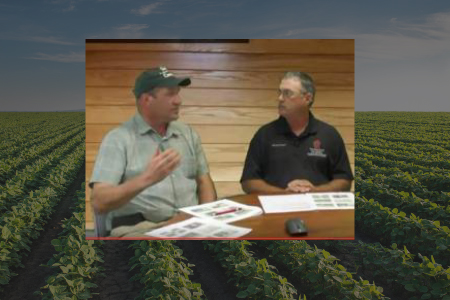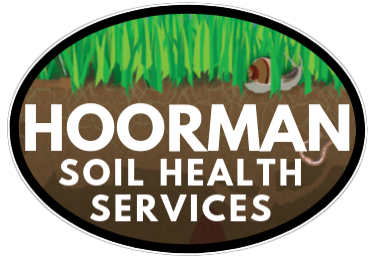Front Fold Crop Roller
See the 30 ft. front fold I&J Crop Roller in action.
See the 30 ft. front fold I&J Crop Roller in action.
Food Plot Crop Roller
I&J Manufacturing makes several Crop Rollers that are used to manage wildlife food plots.
I&J Manufacturing makes several Crop Rollers that are used to manage wildlife food plots.
Flip Over Crop Roller
See the I&J Flip Over Crop Roller in action.
See the I&J Flip Over Crop Roller in action.
Challenger with Crop Roller
Challenger MT665D rolling a cover crop of rye ahead of the soybean planter with an I&J MFG Crop Roller.
Challenger MT665D rolling a cover crop of rye ahead of the soybean planter with an I&J MFG Crop Roller.
How Mineral Nutrition & Humates
Boost Your Bottom Line
with Jim Hoorman
In this episode of the Strip-Till Farmer podcast, brought to you by SOURCE by Sound Agriculture, soil health specialist Jim Hoorman gives us a preview of his presentation for the 2022 National Strip-Tillage Conference about mineral nutrition and humates.
Boost Your Bottom Line
with Jim Hoorman
In this episode of the Strip-Till Farmer podcast, brought to you by SOURCE by Sound Agriculture, soil health specialist Jim Hoorman gives us a preview of his presentation for the 2022 National Strip-Tillage Conference about mineral nutrition and humates.
A Podcast conducted by Diego Footer
A Podcast conducted by Diego Footer interviewing Jim Hoorman from Hoorman Soil Health Services on Soil Ecology, Nutrient Management, and Soil Conservation.
A Podcast conducted by Diego Footer interviewing Jim Hoorman from Hoorman Soil Health Services on Soil Ecology, Nutrient Management, and Soil Conservation.
A Podcast conducted by Diego Footer
Jim Hoorman, Hoorman Soil Health Services discusses soil compaction and ways to improve soil structure. Jim also shows how to look for Boron, Calcium, and Manganese Deficiencies on corn leaves and how solve these issues.
Jim Hoorman, Hoorman Soil Health Services discusses soil compaction and ways to improve soil structure. Jim also shows how to look for Boron, Calcium, and Manganese Deficiencies on corn leaves and how solve these issues.
Virtual Ohio No-Till Event
The Ohio No-till Council has taped a webinar on no-till and cover crop topics. Jim Hoorman has a soil health segment on soil compaction and ways to identify and improve soil structure.
Topics are: Cover crop plots (with Cody Beacom); 60-inch corn (with Josh Yoder); Soil Health (Jim Hoorman); and a Panel on no-till, cover crops and beginning/young no-tillers (Martha Winters, Cody Beacom, Fred Yoder and Nathan Brown).
Also, Paul Jasa, U. of Nebraska, who was our scheduled keynote speaker, has several videos on YouTube, including these two:
The Ohio No-till Council has taped a webinar on no-till and cover crop topics. Jim Hoorman has a soil health segment on soil compaction and ways to identify and improve soil structure.
Topics are: Cover crop plots (with Cody Beacom); 60-inch corn (with Josh Yoder); Soil Health (Jim Hoorman); and a Panel on no-till, cover crops and beginning/young no-tillers (Martha Winters, Cody Beacom, Fred Yoder and Nathan Brown).
Also, Paul Jasa, U. of Nebraska, who was our scheduled keynote speaker, has several videos on YouTube, including these two:
Jim Hoorman - Enhancing Mycorrhizae And Metarhizium Fungus
Mycorrhizae fungus enhance plant nutrient in our agricultural crops and also perform many other functions including improving macroaggregates, disease suppression, improving soil porosity and water drainage, and improving drought resistance. Mycorrhizae fungi bring back 6X more phosphorus and many other micronutrients than the plant root can by itself. Corn roots can explore only about 1% of the soil volume but with the aid of mycorrhizae, they can explore up to 20% of the soil volume for water and nutrients. Metarhizium fungi kill over 200 insect species but also enhance nitrogen uptake in the plant.
Mycorrhizae fungus enhance plant nutrient in our agricultural crops and also perform many other functions including improving macroaggregates, disease suppression, improving soil porosity and water drainage, and improving drought resistance. Mycorrhizae fungi bring back 6X more phosphorus and many other micronutrients than the plant root can by itself. Corn roots can explore only about 1% of the soil volume but with the aid of mycorrhizae, they can explore up to 20% of the soil volume for water and nutrients. Metarhizium fungi kill over 200 insect species but also enhance nitrogen uptake in the plant.

"Soil is meant to be covered..."
Jim Hoorman Speaks about Cover Crops
in Soil Health Series Live Streamin
"Soil is meant to be covered" said Hoorman. "Each cover crop is designed for a special purpose. Legume cover crops, for instance, are typically used to produce homegrown nitrogen. Grass cover crops are used to increase soil organic matter, recycle excess nutrients, and reduce soil compaction. Brassica covers are grown to loosen the soil, recycle nutrients and suppress weeds and plant pathogens. Other covers are grown to suppress harmful insects or attract beneficial insects".
The interview featured most common questions farmers may have about cover crops, such as: What are the most popular species of cover crops in our region? When can cover crops be planted? What species do best at what time of year planting? What are ways to terminate cover crops? and What are sources of cover crop seeds?
Jim Hoorman Speaks about Cover Crops
in Soil Health Series Live Streamin
"Soil is meant to be covered" said Hoorman. "Each cover crop is designed for a special purpose. Legume cover crops, for instance, are typically used to produce homegrown nitrogen. Grass cover crops are used to increase soil organic matter, recycle excess nutrients, and reduce soil compaction. Brassica covers are grown to loosen the soil, recycle nutrients and suppress weeds and plant pathogens. Other covers are grown to suppress harmful insects or attract beneficial insects".
The interview featured most common questions farmers may have about cover crops, such as: What are the most popular species of cover crops in our region? When can cover crops be planted? What species do best at what time of year planting? What are ways to terminate cover crops? and What are sources of cover crop seeds?
Unlocking the Secrets of the Soil: Science of Soil Health:
Compaction
What's the best way to restore compacted soil? Cover crops. Cover crops and crop roots add soil organic matter (SOM) and root exudates which improve soil structure. The majority of SOM comes from plant roots which add soil porosity and add carbon to our soils. Carbon is the storehouse for soil nutrients.
Compaction
What's the best way to restore compacted soil? Cover crops. Cover crops and crop roots add soil organic matter (SOM) and root exudates which improve soil structure. The majority of SOM comes from plant roots which add soil porosity and add carbon to our soils. Carbon is the storehouse for soil nutrients.
Unlocking the Secrets of the Soil: Science of Soil Health:
Plants Feed the Soil Organisms and Vice Versa
Plants feed soil organisms and they feed the plants. Plant roots use 25 to 45% of their total carbohydrate root reserves to feed soil microbes. The microbes use that energy in the form of sugars to bring back water and soluble nutrients to feed the plant. Each microbe is just a soluble bag of fertilizer to feed the plant. There is roughly 1,000 to 2,000X more microbes around plant roots than there is in the bulk soil without plant roots.
Plants Feed the Soil Organisms and Vice Versa
Plants feed soil organisms and they feed the plants. Plant roots use 25 to 45% of their total carbohydrate root reserves to feed soil microbes. The microbes use that energy in the form of sugars to bring back water and soluble nutrients to feed the plant. Each microbe is just a soluble bag of fertilizer to feed the plant. There is roughly 1,000 to 2,000X more microbes around plant roots than there is in the bulk soil without plant roots.
Environmental Impacts of Cover Crops - Jim Hoorman
Cover Crops have a huge effect on soil properties and how soluble nutrients are stored in the soil. Phosphorus in Lake Erie is causing eutrophication and harmful algal blooms (HAB). Cover crops roots increase water infiltration, tie up soluble nutrients like nitrogen and phosphorus, and build up soil organic matter. Cover crops tie up P in the organic form which is plant available but plant roots also influence the inorganic forms (aluminum, iron, calcium, magnesium) forms which are not plant available. Too much tillage and a lack of plant roots cause anerobic (lack of oxygen) and saturated soil conditions which allows ferric iron (Fe3+ reddish pink soil) to convert to ferrous iron (Fe2+ blue-gray soil) releasing soluble reactive phosphorus to surface water.
Cover Crops have a huge effect on soil properties and how soluble nutrients are stored in the soil. Phosphorus in Lake Erie is causing eutrophication and harmful algal blooms (HAB). Cover crops roots increase water infiltration, tie up soluble nutrients like nitrogen and phosphorus, and build up soil organic matter. Cover crops tie up P in the organic form which is plant available but plant roots also influence the inorganic forms (aluminum, iron, calcium, magnesium) forms which are not plant available. Too much tillage and a lack of plant roots cause anerobic (lack of oxygen) and saturated soil conditions which allows ferric iron (Fe3+ reddish pink soil) to convert to ferrous iron (Fe2+ blue-gray soil) releasing soluble reactive phosphorus to surface water.
Biology of Soil Compaction Webinar March 2014
This national webinar shows how soil compaction is a biological problem related to a lack of roots in the soil profile and poor soil structure. Plant roots form macroaggregates which allows the soil to have more porosity and improve soil structure. Tillage destroys soil structure and turns soil into cement.
This national webinar shows how soil compaction is a biological problem related to a lack of roots in the soil profile and poor soil structure. Plant roots form macroaggregates which allows the soil to have more porosity and improve soil structure. Tillage destroys soil structure and turns soil into cement.
South Dakota March 2013 Dakota: Biology of Soil Compaction
Similar video showing how soil compaction is a biological problem related to a lack of roots in the soil profile and poor soil structure. Plant roots form macroaggregates which allows the soil to have more porosity and improve soil structure. Tillage destroys soil structure and turns soil into cement.
Similar video showing how soil compaction is a biological problem related to a lack of roots in the soil profile and poor soil structure. Plant roots form macroaggregates which allows the soil to have more porosity and improve soil structure. Tillage destroys soil structure and turns soil into cement.
ECO Farming: A New Farming System for the 21st Century
This short clip was produced in 2011 at a field day in Mercer County Ohio. Jim Hoorman, Ray Archuleta, Dave Brandt, and Jeff Rasawehr talk about a new concept call ECO Farming. The idea was to do 1) Eternal No-till 2) Cover crops and 3) Other best management practices to improve soil structure, feed the plant, and reduce water and nutrient runoff in Grand Lake St. Marys
This short clip was produced in 2011 at a field day in Mercer County Ohio. Jim Hoorman, Ray Archuleta, Dave Brandt, and Jeff Rasawehr talk about a new concept call ECO Farming. The idea was to do 1) Eternal No-till 2) Cover crops and 3) Other best management practices to improve soil structure, feed the plant, and reduce water and nutrient runoff in Grand Lake St. Marys



